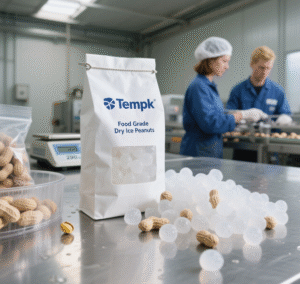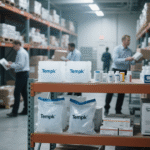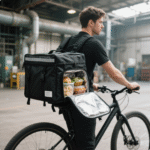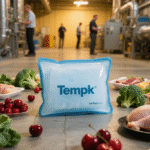-
What “dry ice packing peanuts” really means
-
O 2025 rules you must meet (IATA, PONTO, USPS)
-
Step‑by‑step packout (audit‑ready)
-
How much dry ice? Quick estimator
-
Which peanuts: EPS vs. biodegradable vs. paper
-
CO₂ safety: ventilação, exposure limits, signage
-
QA: rótulos, documents, acceptance checks
-
Perguntas frequentes
1) What “dry ice packing peanuts” really means
Direct answer: It’s the combination de gelo seco (to hold temperature) and packing peanuts (to remove dead air and prevent product movement) inside an isolado, vented shipper. Regulations require CO₂ to vent; packages must be marked UN 1845 and show the net mass of dry ice (kg).
Air waybill text: Many university and carrier job‑aids require wording similar to: “Dry ice, 9, UN1845, number of packages X, net weight in kilograms.” Check your operator’s variation.
2) O 2025 rules you must meet (IATA, PONTO, USPS)
-
IATA DGR 66th ed. (2025) + Addendum 1 (Apr 30, 2025): Dry ice shipped without other DG uses the Acceptance Checklist for Dry Ice (when a Shipper’s Declaration isn’t required). Keep state/operator variations in mind.
-
PONTO (NÓS) 49 CFR §173.217: Packaging must permit CO₂ release; mark UN 1845 e o net mass of dry ice on the package.
-
USPS Publication 52, Instr. 9UM (domestic mail): Specific limits/packaging for dry ice; follow §349 plus 9A details for air pieces. International mail with dry ice is prohibited.
Observação: Some acceptance job‑aids and EHS guides cite 200 kg max net dry ice per package under PI 954; operators may set stricter limits—always check carrier variations.
3) Step‑by‑step packout (audit‑ready)
-
Pick the shipper: EPS/EPP cooler (VIP for long lanes) nested in a corrugated outer.
-
Prep the payload: Bag/seal anything that may leak or thaw.
-
Load dry ice: Lugar around and above the product (do not wrap or seal dry ice); the package must vent.
-
Fill voids: After loading dry ice, eliminate remaining air space with packing peanuts or crumpled paper to immobilize contents and slow sublimation.
-
Close & mark: Apply Aula 9 label, UN 1845, net dry‑ice kg, and shipper/consignee addresses to a vertical side panel; complete air waybill text.
Pro tip (acceptance speed): FedEx job‑aids highlight UN‑number mark size guidance (≥12 mm when package capacity >30 kg). Check the current job‑aid for your region.
4) How much dry ice? Quick estimator
Planning rule of thumb: 5–10 lb (2.3–4.5 kg) per 24 h for small insulated shippers (validate on your lane; add a delay buffer).
Estimator (include a buffer):
-
Escolher days = ceil(hours/24)
-
Start at 3.6 kg/day (midpoint) × cooler factor (0.6 good / 1.0 média / 1.4 poor)
-
Add 20% delay buffer.
Example: 48 h, average cooler → 3.6×2×1.0 = 7.2 kg → +20% ≈ 8.6 kg gelo seco.
5) Which peanuts: EPS vs. biodegradable vs. paper
| Material | Best use with dry ice | Moisture behavior | Weight impact | Notes |
|---|---|---|---|---|
| EPS (polystyrene) peanuts | Robust lanes; humid routes | Low moisture sensitivity | Lightest | Check local bans on EPS loose‑fill (por exemplo, NY statewide since 2022; WA since 2023; OR law effective 2025 prohibits sale of foam peanuts). |
| Biodegradable starch peanuts | Eco‑messaging; dry lanes | Water‑soluble; can slump with condensation | Heavier per volume (typ. 0.4–0.8 lb/ft³) | Starch films/coatings are hydrophilic; moisture resistance is weaker unless modified. |
| Paper/honeycomb | Bracing corners; humid routes | Low moisture risk | Moderate | Reciclável; good mixed with EPS or starch depending on route. |
Why fill voids at all? Dead‑air space speeds sublimation; removing it helps retain refrigerant and stabilizes temperature.
6) CO₂ safety: ventilação, exposure limits, signage
-
Gas volume: 1 lb dry ice → ~8.3–8.7 ft³ CO₂ at ambient conditions—plan room ventilation and vehicle airflow accordingly.
-
Exposure limits: OSHA PEL 5,000 ppm (8‑h TWA); NIOSH STEL 30,000 ppm, IDLH 40,000 ppm. Use monitors in small staging rooms.
-
Do not airtight‑seal inner liners or coolers; packaging must allow CO₂ to vent.
7) QA: rótulos, documents, acceptance checks
-
Air waybill (when no DG declaration): Include “Dry ice, 9, UN1845, number of packages X, net weight in kilograms.”
-
Acceptance checklist: Use IATA’s Dry Ice Acceptance Checklist and your carrier’s job‑aid at tender.
-
Common errors: Missing net kg, labels on top/bottom panels, or covering marks with tape. Follow carrier job‑aids for placement/size.
8) Perguntas frequentes
Q1. Is there really a product called “dry ice packing peanuts”?
Não. It’s a packout method: dry ice for cooling + peanuts for void fill inside a vented insulated shipper marked UN 1845 with net kg.
Q2. How much dry ice for 48 horas?
Most small/medium insulated parcels plan ~5–10 lb per day; for 48 h you’ll typically load 5–9 kg, plus a delay buffer. Validate on your lane.
Q3. Can I use biodegradable peanuts with dry ice?
Yes—just keep them seco. Starch‑based loose‑fill is water‑soluble and can slump under condensation; choose EPS or paper for humid routes.
Q4. What must be on the box?
Aula 9 label, UN 1845, e net dry‑ice weight (kg), plus shipper/consignee addresses; follow IATA/49 CFR and carrier job‑aids.
Q5. Are there state bans impacting EPS peanuts procurement?
Sim. Exemplos: NY (2022), WA (2023), OR (2025) restrict sale/distribution of EPS loose‑fill. Source EPS alternatives when shipping into those markets.
























